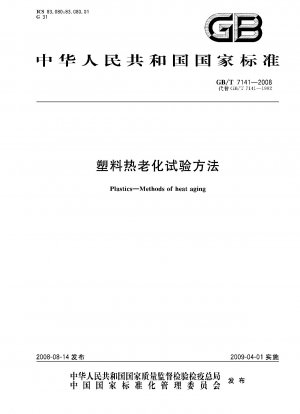GB/T 7141-2008
Plastics.Methods of heat aging (English Version)
- Standard No.
- GB/T 7141-2008
- Language
- Chinese, Available in English version
- Release Date
- 2008
- Published By
- General Administration of Quality Supervision, Inspection and Quarantine of the People‘s Republic of China
- Latest
- GB/T 7141-2008
- Replace
- GB/T 7141-1992
- Scope
- This standard specifies the exposure conditions for plastics only when they are exposed to hot air at different temperatures for a longer period of time. This standard only specifies the method of heat exposure, but does not specify the test method or experiment. The influence of heat on any performance of plastics can be determined by selecting suitable test methods and samples. This standard recommends using the ASTM D3826 standard to determine the embrittlement end point. The embrittlement end point refers to the initial strain rate of 0.1mm/min. When the elongation at break of 75% of the tested samples is 5% or less, the material reaches its embrittlement end point. This standard gives guidelines for comparing the heat aging properties of materials as measured by changes in certain related properties (that is, embrittlement properties as measured by reduction in elongation). This standard is suitable for evaluating plastics that are easily oxidized during use. Results obtained in accordance with this standard are influenced by the type of heat aging chamber used. Users can choose one of two methods for heat aging chamber exposure. Results based on these two methods should not be confused with each other. Method A: Gravity convection thermal aging test chamber - recommended for thin samples with a nominal thickness not greater than 0.25mm. Method B: Forced-air heat aging test chamber—recommended for specimens with a nominal thickness greater than 0.25mm. This standard describes a method for comparing the thermal aging properties of materials at a single temperature. This International Standard describes a method for determining the thermal aging properties of materials at a range of temperatures to estimate the time required for a material to undergo a specified property change at a lower temperature. This standard does not predict heat aging performance under the interaction of factors such as stress, environment, temperature, and time-controlled failure. This standard does not address the relevant safety instructions, if any, it is only relevant to its application. It is the responsibility of the user of this standard to establish applicable safety and health practices and to determine applicable regulatory limitations prior to use.
GB/T 7141-2008 Referenced Document
- ASTM D3826-98(2002) Standard Practice for Determining Degradation End Point in Degradable Polyethylene and Polypropylene Using a Tensile Test
- GB/T 11026.4-1999 Guide for the determination of thermal endurance properties of electrical insulating materials-Part 4: Ageing ovens-Single-chamber ovens
- GB/T 2035 Terms and definitions for plastics
- GB/T 2918 Standard environment for conditioning and testing of plastic specimens*, 2019-11-01 Update
- GB/T 7142 Determination of time-temperature limits for plasties after prolonged exposure to heat
- ISO 16014-2 Plastics — Determination of average molecular weight and molecular weight distribution of polymers using size-exclusion chromatography — Part 2: Universal calibration method*, 2019-05-15 Update
GB/T 7141-2008 history
- 2008 GB/T 7141-2008 Plastics.Methods of heat aging
- 1992 GB/T 7141-1992 Plastics-Methods of exposure to thermal air
